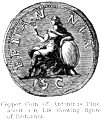Britannia
(
Βρεττανία), called also
Albion. An island in the Atlantic Ocean, and the largest in Europe. The
Phœnicians appear to have been early acquainted with it, and to have carried on
there a traffic for tin. (See
Cassiterides.)
Commercial jealousy, however, induced them to keep their discoveries a profound secret. The
Carthaginians succeeded to the Phœnicians, but were equally mysterious.
Avienus (q.v.) in his poem entitled
Ora
Maritima, makes mention of the voyages of a certain Himilco, in this quarter, and
professes to draw his information from the long-concealed Punic annals. Little was known of
Britain until Caesar's time, who invaded and endeavoured, although ineffectually, to conquer
the island. After a long interval, Ostorius, in the reign of Claudius, reduced the southern
part of Britannia; and Agricola subsequently, in the reign of Domitian, extended the Roman
dominion to the Frith of Forth and the Clyde. The whole force of the Empire, although exerted
to the utmost under Septimius Severus, could not, however, reduce to subjection the hardy
natives of the highlands. This emperor divided the country into two parts—Britannia
Inferior or Southern Britain, and Britannia Superior or Northern
Britain—each under a special prefect. When the Empire was divided under Diocletian,
Britain became a diocese of the
praefectura of Gaul, and was governed by
a
vicarius residing at Eboracum (York). At this time it was marked out
into five provinces, as follows: Britannia Prima (England south of the Thames), Britannia
Secunda (Wales), Flavia Caesariensis (between the Thames, Severn, Mersey, and Humber), Maxima
Caesariensis (all the rest of England up to the Wall of Hadrian), and Valentia (Scotland south
of the Wall of Antoninus). Ptolemy enumerates fifty-six towns (
coloniae,
municipia) of Roman Britain, two of which (Eboracum and Verulamium) had the rights of
Roman citizenship. Eboracum, Deva (Chester,
castra), and Isca (Caerleon)
were military centres, each being the station for a legion of Roman soldiers, chiefly,
however, Gauls, Germans, and Iberians.
To what an extent the Romans succeeded in introducing the refinements of their civilization
into
 |
|
Copper Coin of Antoninus Pius, about A.D. 138, showing figure of Britannia.
|
Britain may be seen in the great number of their remains that have been found,
including roads, houses, baths, painted walls, altars, ornaments, mosaics, sculpture, bronzes,
coins, pottery, and various implements. Britain continued a Roman province until A.D. 426,
when the troops, having been in a great measure withdrawn to assist Valentinian III. against
the Huns, never returned. The Britons had become so enervated under the Roman yoke as to be
unable to repel the incursions of the inhabitants of the north. They invoked, therefore, the
aid of the Saxons (A.D. 407), by whom they were themselves subjugated and at length obliged to
take refuge in the mountains of Wales.
The name Britain was unknown to the Romans before the time of Caesar; though Aristotle as
early as the fourth century B.C. speaks of the
νῆσοι
Βρεταννικαί. Some deduce the name of the Britons from the Gallic
Britti (Cymric
brîth),
“painted,” in allusion to the custom of a part of the inhabitants of
painting their bodies; but Rhys rejects this etymology, without suggesting any that is more
plausible. The other name, Albion, is etymologically connected with the Gaelic
alp, “a high hill,” or the Latin
albus, “white.” This was undoubtedly the Keltic name of the whole
island.
Britain was famous for its Roman walls, of which traces remain to the present day. The first
was built by Agricola, A.D. 79, nearly in the situation of the rampart of Hadrian and wall of
Severus mentioned below. In A.D. 81, Agricola built a line of very strong forts from the Frith
of Forth to the Frith of Clyde. This, however, was insufficient to check the barbarians after
his departure. In A.D. 120, therefore, Hadrian erected a famous wall from Boulness on Solway
Frith to a spot a little beyond Newcastle-upon-Tyne. It was sixty-eight English or
seventy-four Roman miles long. Twenty years after this, Lollius Urbicus, under the emperor
Antoninus, restored the second wall of Agricola, which is commonly called the Vallum
Antonini. But the greatest of all was that of Severus, begun A.D. 209, and finished the next
year, and which was only a few yards north of Hadrian's wall. It was garrisoned by ten
thousand men. See
Wright, The Kelt, the Roman, and the Saxon
(1889);
Coote, The Romans of Britain (1878);
Scarth,
Roman Britain (1883).





